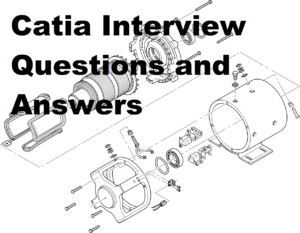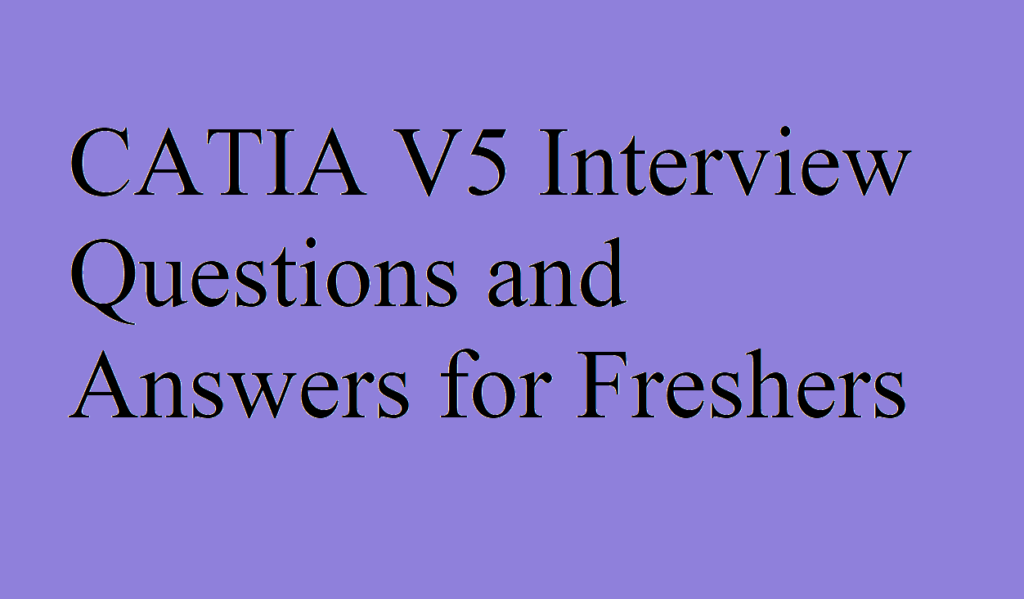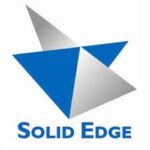CATIA V5 Interview Questions and Answers for Freshers | Experienced.
If you are mechanical engineer and preparing for mechanical design interview based on CATIA V5. You are at the best place. Here are the mechanical design interview questions based on CATIA V5 section wise i.e., Sketching, Part design, Surfacing.
SKETCHING
Q.1 Expand CATIA?
Ans: Computer Aided Three-Dimensional Interactive Application.
Q.2 What is the save extension of sketcher file?
Ans: CATPart.
Q.3 Does CATIA V5 work on Unix platform?
Ans: Yes.
Q.4 Is it possible to increase the size of plane boundary representation and how?
Ans: Yes, go for Tools-Options-Infrastructure-Part Structure-Display.
Q.5 Is it possible to directly enter into sketcher workbench?
Ans: No, it is not possible to enter into sketcher workbench directly. We have to go for any workbench and from there we can enter the sketcher workbench.
Q.6 What is the tool use to exit from CATIA sketcher workbench to CATIA part design workbench?
Ans: Exit CATIA sketcher.
Q.7 What are default units for LMT?
Ans: Mm, kg, sec.
Q.8 What is use of construction elements?
Ans: Construction elements assist in sketching the required profile in sketcher workbench.
Q.9 What is SKETCH TOOLS in sketcher work bench and explain the importance of it?
Ans: SKETCH TOOLS in sketcher workbench are the commands, which find their very uses in creating sketches. Sketch tools are namely geometric and dimensional constraints, construction elements and grid options. They play very important role in sketching, whenever we want to constrain a sketch, we use these options and if we want to convert any element into a construction element once again these options come into picture.
Q.10 Difference between geometrical and dimensional constraints?
Ans: Geometric constraint is a relationship that forces a limitation between one or more geometric elements.
Dimensional constraint is a constraint, whose value determines the geometric object measurement.
Top 50 solid edge Interview questions and answers
Q.11 What is show hide mode?
Ans: Show mode enable us to see all the components presently opened and in hide mode we can hide the desired elements from the view for time being.
Q.12 Is it possible to hide specification tree?
Ans: Yes, with help of F3 button, but the option in Tools command must be checked to allow this.
Q.13 How do you measure arc length?
Ans: We can measure an arc length by help of MEASURE ITEM command. Sometimes we need to customize the option for arc length if it is not checked earlier using customization in MEASURE ITEM command.
Q.14 What is the meaning of true dimensions?
Ans: True dimension is the dimension desired after the machining. In other words, this is the value that should be attained after the machining.
Q.15 Difference between stacked dimensions and chained dimensions mode while using auto constraint option?
Ans: In stacked dimension all the dimensions will be measured with respect to other reference. In chained dimension the dimensions will be measured one with respect to other.
Q.16 What for Animated constraint command is used?
Ans: This task shows how constrained sketched element reacts when we decide to vary one constraint.
Q.17 How many dimensions are require to constraint the ellipse?
Ans: Three dimensions are require namely major axis, minor axis and the distance from the origin.
Q.18 What are different conic section?
Ans: Ellipse, Hyperbola and Parabola.
Q.19 What is the difference between symmetry command and mirror command?
Ans: In symmetry command, the original sketch is deleted and the new one is created about the reference plane but with the help of mirror command we can retain both the new one and the original sketch about the reference plane.
Q.20 What is NURBS?
Ans: Nurbs are the types of curves.
Q.21 How many types of co-ordinates systems are there?
Ans: Three, namely, Cartesian. Polar and spherical co-ordinate systems.
Q.22 Difference between trim and quick trim?
Ans: In trim option, we can extend a line along with trimming of other of other unwanted elements. In quick trim we can only trim a line or curve and we can not extend or shorten it.
Q.23 What is use of sketch analysis?
Ans: To check the whether the sketch is fully closed or not so that the sketch can be used for further operations in part design.
Q.24 Where do we use axis?
Ans: Axis is uses in creating revolve feature, eg., shaft.
Q.25 Difference between axis and construction elements?
Ans: Axis is visible in part design mode and can be selected but construction elements are invisible in part design mode and are not selectable.
Q.26 Can we redefine the sketches?
Ans: Yes
Q.27 Can axis can be convert in line or vice versa?
Ans: We can convert line into axis but axis cannot convert into line.
Q.28 How many axes can be create in a single sketch?
Ans: Only one axis can be created in single sketch, if more than one axes are drawn then only one of them, the least one will be axis and others will be converted into reference elements.
Q.29 What is the function of mirror command in sketch?
Ans: Mirror command in sketch will create a copy of the sketch about a reference plane.
Q.30 If I do not want relation between original and mirrored element what should I do?
Ans: Explode and the relation between the original and mirror elements doesn’t exist.
Q.31 What is use of isolate in sketcher workbench?
Ans: Isolate is used when 3d geometry is projected onto a sketch in order to be modified and used as part of the sketch’s profile.
Q.32 Can we select non-planer surface as sketch plane?
Ans: NO, we cannot select non planer surface as sketch.
Q.33 How may degrees of freedom are there for points, lines, circles and ellipse in two dimensions?
Ans: Degree of freedom for point and line is 2, for circle it is 3 and for ellipse it is 5 in two dimensions.
Q.34 What is difference between isolate and separate?
Ans: Isolate- deletes logical link between the elements.
Separate- Separates lines, curves, faces from there links with other elements.
Q.35 What is the kernel of CATIA?
Ans: C NEXT.
PART DESIGN
Q.36 Expand CAD/ CAM/ CAE/ PLM/ PDM/ VPM/ VPDM/ CFD?
Ans: Computer added (Design/ Manufacturing/ Engineering)/ Product Life cycle Management/ Virtual Product Module/ Virtual product data management/ Computational fluid Dynamics.
Q.37 Is it possible to create pocket or groove as first feature in CATIA?
Ans: Yes, it is possible in CATIA.
Q.38 How to give tolerance to a particular dimension?
Ans: First, give the dimension and using right click select add tolerance from the contextual menu and specify the tolerance.
Q.39 What is the use of create datum?
Ans: Deactivates the links between parts.
Q.40 Can you pad open and intersecting profile?
Ans: Possible for open profile with thin pad option. Not possible with intersecting profiles.
Q.41 Difference between pad and multi pad?
Ans: A PAD is uses for single profile and MULTIPAD is uses for multi profile sketch.
Q.42 Can we use arc as axis for creating shaft feature?
Ans: No, we can not use an arc as axis for creating shaft.
Q.43 What is power copy?
Ans: A set of features that are grouped under to use in different context and having the capability to adapt changes when pasted.
Q.44 Is it possible to create negative body?
Ans: Yes, using insert menu and insert body option.
Q.45 How do you differentiate positive and negative body?
Ans: A positive body is the one which when assembled with another body it gets added and negative body is the one which when assembled with positive body will get subtracted and it will get added if Boolean operations add is used instead of assemble.
Q.46 What is use of REMOVE LUMP?
Ans: Removing of material that is not physically connected to anybody.
Q.47 What is use of ‘Reorder’?
Ans: The capability of reorder command allows us to rectify design mistake by reordering operations.
Q.48 What is the use of PULLING DIRECTION in rib option?
Ans: It sweeps the profile with respect to a specified direction. To select this direction, select a plane or an edge.
Q.49 How do I create a plane at an angle to another plane?
Ans: Using the option Angle/Normal to plane in PLANE command.
Q.50 What are different types of coupling modes are there in loft?
Ans: Ratio, Vertices, Tangency Discontinuity, Curvature then tangency discontinuity.
Q.51 Is it possible to pattern the two or more features at a time?
Ans: Yes (By multiselecting the feature and then selecting the pattern command)
Q.52 What is meaning of explode in pattern?
Ans: De-activating the link between patterns and make them as independent entities.
Q.53 What is ‘keep angle’ in rib and slot?
Ans: Keep angle option in ribs and slots lets us to keep angle value between the sketch plane used for the profile and the tangent of the center curve.
Q.54 Is it possible to split using the SEW operation?
Ans: Yes
Q.55 What is a functional surface?
Ans: A functional surface is the element that defines the face on a solid.
Q.56 What is IUA? What is its purpose?
Ans: IUA=Interactive User Application. Its purpose is to customize the CATIA user command.
Q.57 What is difference between Affinity and scaling?
Ans: Scaling- Resizing the body to the scale that you specify, in all the direction equally.
Affinity – Resizing the body to the scale, which you specify in a particular direction only, specified by you.
Q.58 What is the use of law function?
Ans: The uses of law function involve the creation of geometry to control the differing aspects of a surface.
Q.59 What are solid primitives?
Ans: Solid primitives are the ready-made features available in a particular for use. One just need to enter the dimensions and can have solid ready-made e.g – Box, cylinder, Cone, Sphere.
Q.60 What is ‘reference surface’ option in ribs and slots?
Ans: It sweeps the profile while keeping the angle value between the axis and the reference surface constant.
SURFACING
Q.61 What is thickness of surface?
Ans: Infinitely less
Q.62 What is hybrid modelling?
Ans: Mixture of solid and surface modelling.
Q.63 Is it possible to set the default colour for surface?
Ans: Yes, we can set default colour for surface in CATIA.
Q.64 List the different commands available to create surface?
Ans: Extrusion, revolve, sweep, fill and multi-section.
Q.65 What is use of ‘federation’ option in ‘join’?
Ans: The purpose of federation is to regroup several elements making up joined surface or curve. This is especially useful when modifying linked geometry to avoid respecifying all input elements.
Q.66 Is it possible to perform a shell operation on a sphere?
Ans: Yes, we can shell a sphere. For this we need to just select the shell command and give wall thickness. If we select the sphere as object to be shelled then it will show some error and we cannot shell it.
Q.67 What is healing of geometry?
Ans: This task shows how to heal surfaces, that is, how to fill any gap that may be appealing between two surfaces.
Q.68 What is smoothening of curves?
Ans: This task shows how to smooth a curve, i.e., fill the gaps and smooth the tangency curvatures discontinuities, in order to generate better quality geometry when using this curve to create other elements, such as swept surfaces for examples.
Q.69 What is ‘simplify results’ in join?
Ans: Checking this button allows the system to automatically reduce the no of elements in resulting join whenever possible.
Q.70 What is the file save extension of surface?
Ans: .CATPart is the file save extensions in CATIA surfacing.



Thanks for valuable knowledge
very informative. thank you for sharing!
Pingback: How to Select Right Bearing for your Application | Bearing Selection Guide – SKY HIGH eLearn
Pingback: Pipe wall thickness calculation for your application with practical examples
Pingback: Flat belt conveyor design calculations with practical application